






Dr.-Ing. h.c. F. Porsche AG, usually shortened to Porsche, is a German automobile manufacturer specializing in high-performance sports cars, SUVs and sedans, headquartered in Stuttgart, Baden-Württemberg, Germany. The company is owned by Volkswagen AG, a controlling stake of which is owned by Porsche Automobil Holding SE. Porsche's current lineup includes the 718 Boxster/Cayman, 911, Panamera, Macan, Cayenne and Taycan.
Ferdinand Porsche founded the company called "Dr. Ing. h. c. F. Porsche GmbH" with Adolf Rosenberger and Anton Piëch in 1931. The main offices was at Kronenstraße 24 in the centre of Stuttgart.
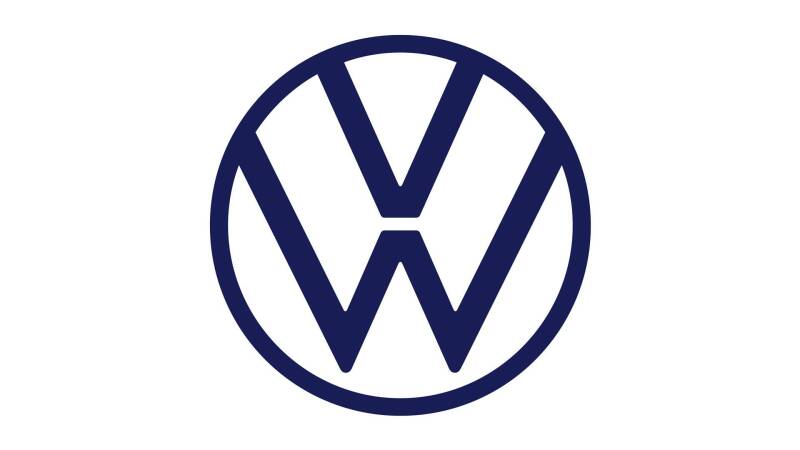
Initially, the company offered motor vehicle development work and consulting, but did not build any cars under its own name. One of the first assignments the new company received was from the German government to design a car for the people; that is, a Volkswagen. This resulted in the Volkswagen Beetle, one of the most successful car designs of all time. The Porsche 64 was developed in 1939 using many components from the Beetle.
During World War II, Volkswagen production turned to the military version of the Volkswagen Beetle, the Kübelwagen, 52,000 produced, and Schwimmwagen, 15,584 produced. Porsche produced several designs for heavy tanks during the war, losing out to Henschel & Son in both contracts that ultimately led to the Tiger I and the Tiger II. However, not all this work was wasted, as the chassis Porsche designed for the Tiger I was used as the base for the Elefant tank destroyer. Porsche also developed the Maus super-heavy tank in the closing stages of the war, producing two prototypes. Ferdinand Porsche's biographer, Fabian Müller, wrote that Porsche had thousands of people forcibly brought to work at their factories during the war. The workers wore the letter "P" on their clothing at all times. It stood not for "Porsche", but for "Poland."
64

1939



The Porsche 64, also known as the Type 64 and Type 60K10, is considered by many to be the first automobile from what was to become the Porsche company, and a true design precursor to the post-war production model. The model number comes from the fact that it was built mainly from design drawings for the Type-64 "record car". Most mechanical parts came from the VW 38, the prototype of the KdF-Wagen better known as the Volkswagen Beetle. The chassis was heavily reinforced and the engine also reworked to produce around 40 horsepower. The Type 64 was only a drawing until the three racers were built. The body was also a compromise in that the cab had to look like a KdF car, but the rest was 'record' car. The VW beetle was the Type 60, and the name the "60K10" means body design 10 for the Type 60 Beetle. Its flat-four engine produced 50 bhp and gave a top speed of around 160 km/h.
On 15 December of that year, Ferdinand was arrested for war crimes, but not tried. During his 20-month imprisonment, Ferdinand Porsche's son, Ferry Porsche, decided to build his own car, because he could not find an existing one that he wanted to buy. He also had to steer the company through some of its most difficult days until his father's release in August 1947. The first models of what was to become the 356 were built in a small sawmill in Gmünd, Austria.[13] The prototype car was shown to German auto dealers, and when pre-orders reached a set threshold, production (with aluminum body) was begun by Porsche Konstruktionen GesmbH, founded by Ferry and Louise. Many regard the 356 as the first Porsche simply because it was the first model sold by the fledgling company. After production of the 356 was taken over by the father's Dr. Ing. h.c. F. Porsche GmbH in Stuttgart in 1950, Porsche commissioned a Zuffenhausen-based company, Reutter Karosserie, which had previously collaborated with the firm on Volkswagen Beetle prototypes, to produce the 356's steel body. In 1952, Porsche constructed an assembly plant (Werk 2) across the street from Reutter Karosserie; the main road in front of Werk 1, the oldest Porsche building, is now known as Porschestrasse. The 356 was road certified in 1948.
356

1948-1965



The Porsche 356 is a sports car that was first produced by Austrian company Porsche Konstruktionen GesmbH (1948–1949), and then by German company Dr. Ing. h. c. F. Porsche GmbH (1950–1965). It was Porsche's first production automobile. Earlier cars designed by the Austrian company include Cisitalia Grand Prix race car, the Volkswagen Beetle, and Auto Union Grand Prix cars.
The 356 is a lightweight and nimble-handling, rear-engine, rear-wheel drive, two-door available both in hardtop coupé and open configurations. Engineering innovations continued during the years of manufacture, contributing to its motorsports success and popularity. Production started in 1948 at Gmünd, Austria, where Porsche built approximately 50 cars. In 1950 the factory relocated to Zuffenhausen, Germany, and general production of the 356 continued until April 1965, well after the replacement model 911 made its September 1964 debut. Of the 76,000 originally produced, approximately half survive.
Porsche 356 production:
356 (1948–1955 ) 7,627
356 A (1955–1959) 21,045
356 B (1959–1963) 30,963
356 C (1963–1965/66) 16,678
550 spyder

1953-1956



The Porsche 550 is a racing sports car produced by Porsche from 1953 until 1956. In that time only 90 Porsche 550s were produced, and they quickly established dominance in the 1.1- and 1.5- liter classes. The Porsche 550 is a mid-engine car with an air-cooled four-cylinder engine, following the precedent of the 1948 Porsche 356/1 prototype designed by Ferry Porsche. The mid-engine racing design was further developed with Porsche's 718 model; its advantages led to it becoming the dominant design for top-level racing cars by the mid-1960s.
The Porsche 550 has a solid racing history; the first race it entered, the Nurburgring Eifel Race in May 1953, it won. The 550 spyder usually finished in the top three in its class. Each spyder was designed and customized to be raced. Its successor from 1957 onwards, the Porsche 718, commonly known as the RSK was even more successful.
The Type 550/550 A is powered by an all aluminium 1498 cc naturally aspirated air-cooled 4 cylinder boxer engine known as the "Fuhrmann Engine" (Type 547). Its valvetrain uses double overhead camshafts on each cylinder bank, driven by vertical shafts, actuating 2 valves per cylinder. In its first version it produced 110 PS.
The first 550 had a fully synchronized 4-speed gearbox. Starting in 1956, a 5-speed gearbox was used, but its first gear only had to start.
911
The Porsche 911 (pronounced Nine Eleven or in German: Neunelfer) is a two-door 2+2 high performance rear-engined sports car introduced in September 1964 by Porsche AG of Stuttgart, Germany. It has a rear-mounted flat-six engine and a torsion bar suspension. The car has been continuously enhanced through the years but the basic concept has remained unchanged. The engines were air-cooled until the introduction of the 996 series in 1998.


Although Porsche has used internal code numbers for each series of the 911, all models have been marketed and sold as 911s. The model series and associated internal codes are as follows:
- 911 (1964–1975)
- 930 (1975–1989) a turbocharged version and the 2nd generation of the original 911.
- 964 (1989–1994)
- 993 (1995–1998) the last air-cooled 911
- 996 (1999–2004) all-new body and water-cooled engines
- 997 (2005–2012)
- 991 (2012–2019) all-new body
- 992 (2019–)
A series letter is used by Porsche to indicate the revision for production cars, usually on an annual basis.
911s have also been categorized into families based on body styles or engine enhancements:
- 911 Carrera: including the Carrera, Carrera S, Carrera 4, Carrera 4S, Carrera GTS, Carrera 4 GTS, Carrera T. All are available as cabriolets except the Carrera T.
- 911 Targa: including the Targa 4, Targa 4S, Targa 4 GTS.
- 911 Turbo: including the Turbo, Turbo S. All are available as cabriolets.
- GT3/GT3 RS: a track-focused version of the 911 Carrera with a naturally aspirated engine and rear wheel drive. No cabriolet variant has ever been produced to date. A grand touring version featuring comfort-oriented options was called the GT3 Touring exclusively within the 991 series.
- GT2/GT2 RS: the highest performance derivative, a track-focused version based on the Turbo with rear wheel drive. No cabriolet version has ever been produced to date. Now available as an RS (Renn Sport) model only.

911
The 911 traces its roots to sketches drawn by Ferdinand "Butzi" Porsche in 1959. The Porsche 911 was developed as a more powerful, larger and a more comfortable replacement for the 356, the company's first model. The new car made its public debut at the 1963 Frankfurt Motor Show (German: Internationale Automobil-Ausstellung). The car was developed with the proof-of-concept twin-fan Type 745 flat-six engine, but the car presented at the auto show had a non-operational mockup of the single-fan 901 engine, receiving a working unit in February 1964.

930
For the 1976 model year, Porsche introduced the Carrera 3.0 with wide rear flares, optional whaletail, and a variety of other luxury options. It was available in all markets except North America. The Carrera 3.0 was fitted with a variation of the 930 Turbo's 2994 cc engine (minus the turbocharger). The engine (dubbed the 930/02) featured K-Jetronic CIS. It developed 200 PS in contrast to the older Carrera 2.7 MFI model's 210 PS .

964
For 1989 the 911 underwent a major evolution with the introduction of the Type 964. With technologies from the 959 flagship model, this would be an important car for Porsche, since the world economy was undergoing recession and the company could not rely on its image alone. It was launched as the Carrera 4, the "4" indicating four-wheel-drive, demonstrating the company's commitment to engineering. A rear spoiler deployed at high speed, preserving the purity of design when the vehicle was at rest. The chassis was redesigned overall. The engine was increased in size to 3,600 cc and was rated at 250 PS.

993
A Turbocharged version of the 993 was launched in 1995 and became the first standard production Porsche with twin turbochargers and the first 911 Turbo to be equipped with permanent all-wheel-drive (the homologated GT2 version based on the Turbo retained RWD). The similarity in specification and in performance levels inspired several comparison road tests with the 959. The 3.6 L twin-turbocharged M64/60 engine is rated at 408 PS. The performance was outstanding at the time, as 0 to 100 km/h has been measured at 3.2 seconds.

996
The Type 996 introduced in 1998 represented two major changes for the venerable 911 lineage: a water-cooled flat-6 engine replaced the popular air-cooled engine used in the 911 for 34 years and the body shell received its first major re-design. Changing to a water-cooled engine was controversial with Porsche traditionalists, who noted this as the end of the 'true' 911. Engine displacement was 3.4 L and power output was 300 PS featuring a change to an "integrated dry sump" design and variable valve timing. The displacement was increased in 2002 to 3.6 L and power received an increase to 320 PS.

997
The 996 was replaced with the 997 in 2005. It retains the 996's basic profile, with an even lower 0.28 drag coefficient, but draws on the 993 for detailing. In addition, the new headlights revert to the original bug-eye design from the teardrop scheme of the 996. Its interior is also similarly revised, with strong links to the earlier 911 interiors while at the same time looking fresh and modern. The 997 shares less than a third of its parts with the outgoing 996, but is still technically similar to it. Initially, two versions of the 997 were introduced— the rear-wheel-drive Carrera and Carrera S

991
The 991 introduced in 2012 is an entirely new platform, only the third since the original 911. Porsche revealed basic information on the new Carrera and Carrera S models on 23 August 2011. The Carrera is powered by a 355 PS 3.4-litre engine. The Carrera S features a 3.8-litre engine rated at 406 PS. A Power Kit (option X51) is available for the Carrera S, increasing power output to 436 PS. In May 2013, Porsche announced changes to the model year 2014 911 Turbo and Turbo S models, increasing their power to 520 PS on the 'Turbo', and 560 PS on the 'Turbo S', giving them a 0–100 km/h acceleration time of 3.2 and 2.9 seconds, respectively.

992
The 2019 version of the 911, under the internal name Type 992, made its debut in 2018. During the actual debut, a presentation of the history of the 911 series was shown, along with a lineup of 911s with different generations. On 30 July 2019 Porsche have started marketing the non 'S' model of the new 992. The exterior is almost identical to the 991 'S's models with the exception of having 19" wheels front and 20" wheels at the rear, compared to the 'S' Models 20" front and 21" rear. For now, Porsche is offering just the Carrera and Carrera S versions, plus the all-wheel-drive 4 and 4S versions
914

1969-1976



By the late 1960s, both Volkswagen and Porsche were in need of new models; Porsche was looking for a replacement for their entry-level 912, and Volkswagen wanted a new range-topping sports coupé to replace the Volkswagen Type 34 Karmann Ghia coupé. At the time the majority of Volkswagen's development work was handled by Porsche as part of an agreement that dated back to Porsche's founding. Volkswagen needed to contract out one last project to Porsche to fulfill the contract, and decided to make the 914 that project. Ferdinand Piëch, who was in charge of research and development at Porsche, was put in charge of the 914 project.
In 1966 and 1967, German company Gugelot Design GmbH began showing a proposed design for a sports coupe built with technology developed in partnership with Bayer to several major car builders, including Volkswagen and Porsche.
Originally intending to sell the vehicle with a flat four-cylinder engine as a Volkswagen and with a flat six-cylinder engine as a Porsche, Porsche decided during development that having Volkswagen and Porsche models sharing the same body would be risky for business in the American market, and convinced Volkswagen to allow them to sell both versions as Porsches in North America. Slow sales and rising costs prompted Porsche to discontinue the 914/6 variant in 1972 after producing 3,351 of them.
924

1976-1988



The 924 was originally a joint project of Volkswagen and Porsche created by the Vertriebsgesellschaft (VG), the joint sales and marketing company funded by Porsche and VW to market and sell sports cars (Ludvigsen: Porsche, Excellence was Expected). For Volkswagen, it was intended to be that company's flagship coupé sports car and was dubbed "Project 425" during its development. For Porsche, it was to be its entry-level sports car replacing the 914. At the time, Volkswagen lacked a significant internal research and design division for developing sports cars; further, Porsche had been doing the bulk of the company's development work anyway, per a deal that went back to the 1940s. In keeping with this history, Porsche was contracted to develop a new sporting vehicle with the caveat that this vehicle must work with an existing VW/Audi inline-four engine. Porsche chose a rear-wheel drive layout and a rear-mounted transaxle for the design to help provide 48/52 front/rear weight distribution; this slight rear weight bias aided both traction and brake balance.
The 924 was discontinued in 1988, with Porsche concentrating on producing the faster 944 as its entry-level model.
944

1982-1991



The Porsche 944 is a sports car manufactured by German automobile manufacturer Porsche from 1982 to 1991. A front-engine, rear-wheel drive mid-level model based on the 924 platform, the 944 was available in coupé or cabriolet body styles, with either naturally aspirated or turbocharged engines. With over 163,000 cars produced, the 944 was the most successful sports car in Porsche's history until the introductions of the Boxster and 997 Carrera.
Extensive design revisions for the 1992 model year prompted Porsche to drop the 944 nameplate and rebrand the vehicle as the 968.
In 1982, Porsche debuted the production road legal version of the 924 GTP, called the 944. The car utilised many technologies its race bred sibling had used, including the balance shafts and the engine management system, but power was toned down for safety purposes. The new all-alloy 2,479 cc inline-four engine was in essence, half of the 928's 5.0 L V8 engine, although very few parts were actually interchangeable. Not typical in luxury sports cars, the four-cylinder engine was chosen for fuel efficiency and size, because it had to be fitted from below on the Neckarsulm production line.
For the 1987 model year, the 944 S (the S being the abbreviation of Super) was introduced. The 944 S featured a high performance naturally aspirated, dual-overhead-cam 16-valve 190 PS version of the 2.5 L engine. In 1989 the 944 S2 was introduced, powered by a 211 PS naturally aspirated, dual-overhead-cam 16-valve 3.0 L version of the 944 S' engine.
In early 1990, Porsche engineers began working on what they had intended to be the third evolution of the 944, the S3. As they progressed with the development process, they realised that so many parts were being changed that they had produced an almost entirely new vehicle. Porsche consequently shifted development from the 944 S/S2 to the car that would replace the 944 entirely, the 968. The 944's final year of production was 1991 with over 4,000 cars built and sold. In 1992, the 968 debuted and was sold alongside the 928 until 1995, when both water-cooled front engine models were discontinued without a direct successor
928

1978

1980 s

1992 gts

Ordered by Ferdinand Porsche to design a production-feasible concept for the new model, Fuhrmann initiated a design study in 1971, eventually yielding the 928 which was the first clean sheet design by the company for its own model; the 356 had evolved from the Volkswagen Beetle, the 911 was an evolution of the 356, the 914 was a joint effort intended as a replacement for the Volkswagen Karmann Ghia and 912, and the 924 was the result of abandoned project by Volkswagen and Audi.
The 928 featured a large, front-mounted and water-cooled V8 engine driving the rear wheels. Originally displacing 4.5 L and featuring a single overhead camshaft design, it was rated at 219 hp for the North American market and 240 PS in other markets. Porsche upgraded the engine from mechanical to electronic fuel injection in 1980 for US models, although power remained the same. This design marked a major change in direction for Porsche (started with the introduction of the 924 in 1976), whose cars had until then used only rear- or mid-mounted air-cooled flat engines with four or six cylinders.
Porsche introduced a refreshed 928 S into the European market in 1980 model year. Externally, the S wore new front and rear spoilers and sported wider wheels and tires than the older variant, but the main change for the 928 S was under the hood, where a revised 4.7 L engine was used. European versions debuted with 300 PS, and were upgraded to 310 PS for the 1984 model year.
The S4 and GT variants halted production at the end of the 1991 model year, making way for the final version of the 928. The 928 GTS was available for sale in late 1991 as a 1992 model in Europe and in spring of 1992 as an early 1993 model in North America. Changed bodywork, larger front brakes and a new, more powerful 5.4 L, 350 PS engine were the big advertised changes; what Porsche wasn't advertising was the price.

Production numbers:
928 1978–82 17,66
9928 S 1980–83 8,315
928 S/S2 1984–86 14,347
928 S4 1987–91 15,682
928 CS 1988–89½ 19
928 SE 1988 42
928 GT 1989½–91 2,078
928 GTS 1992–95 2,904
Total 1978–1995 61,056
959

1986-1993



1986 Paris-Dakar Rally
The twin-turbocharged 959 was the world's fastest street-legal production car when introduced, achieving a top speed of 317 km/h, with some variants even capable of achieving 339 km/h. During its production run, the 959 was considered as the most technologically advanced road-going sports car ever built, and forerunner of all forthcoming sports cars. It was one of the first high-performance sports cars with all-wheel drive, providing the basis for Porsche's first all-wheel drive 911 Carrera 4 model. Its performance convinced Porsche executives to make all-wheel drive standard on all turbocharged versions of the 911 starting with the 993. The twin-turbo system used on the 959 also made its way to future turbocharged Porsche sports cars. In 2004, Sports Car International named the 959 number one on its list of Top Sports Cars of the 1980s.
The 959 was originally meant for Group B racing but development time took longer than expected. The first development race cars, essentially modified 911 Carrera models with all-wheel-drive system known internally as the 953, were entered in the 1984 Paris-Dakar Rally, finishing 1st (René Metge), 6th (Jacky Ickx) and 25th. These cars tested the all-wheel-drive system to be used in the 959.
968

1991-1995



The Porsche 968 is a sports car manufactured by German automobile manufacturer Porsche AG from 1991 until 1995.[2] It was the final evolution of a series of water-cooled front-engine rear wheel drive models begun almost 20 years earlier with the 924, taking over the entry-level[citation needed] position in the company lineup from the 944 with which it shared about 20% of its parts. The 968 was Porsche's last new front-engined vehicle before the introduction of the Cayenne SUV in 2003.
Porsche's 944 model debuted for the 1982 model year as an evolution of the 924, was updated as "944S" in 1987 and as "944S2" in 1989. Porsche engineers began working on another set of significant upgrades in order to save development costs. With more then 80% of the parts altered Porsche chose to introduce the variant as a new model, calling it the 968.
The 968 was offered in coupé and convertible bodystyles. The 968 was powered by an updated version of the 944's Inline-four engine, now displacing 3.0 L with 240ps.
Its discontinuation in 1995 due to poor sales coincided with that of the 928, Porsche's only other front-engine car at the time. The 968 was also the last Porsche sold with a four-cylinder engine prior to the introduction of the Porsche Macan in 2014. Production figures for all 968 variants: 12776.
911 gt1



The Porsche 911 GT1 is a car designed and developed by German automobile manufacturer Porsche AG to compete in the GT1 class of sportscar racing, which also required a street-legal version for homologation purposes. The limited-production street-legal version developed as a result was named the 911 GT1 Straßenversion (Street version).
With the revival of international sportscar racing in the mid-1990s through the BPR Global GT Series (which then morphed into the FIA GT Championship) Porsche expressed interest in returning to top-level sportscar racing and went about developing its competitor for the GT1 category. In spite of its 911 moniker, the car actually had very little in common with the 911 of the time, only sharing the front and rear headlamps with the production sports car. However, its frontal chassis is based on the 993-generation 911, while the rear subframe was derived from the 962C along with its water-cooled, twin-turbocharged and intercooled, 4 valves per cylinder 3,164 cc flat-six engine fuel fed by Bosch Motronic 5.2 fuel injection, which was longitudinally-mounted in a rear mid-engine, rear-wheel-drive layout, compared to the rear-engine, rear-wheel-drive layout of a conventional 911. The engine generated a power output of about 600 PS. The 1996 911 GT1 clocked at a top speed of exactly 330 km/h (205 mph) on the legendary Mulsanne Straight in the practice sessions of the 1996 Le Mans 24 Hours Race.

Regulations for the GT1 category stipulated that to be eligible, a total of 25 cars must be built for road use. The production car - dubbed "911 GT1 Straßenversion" - was a run of approximately 20 units which were built in 1997 and featured 996 style front headlights. The majority of the production model was finished in Arctic Silver or Fern White, but three cars were finished in unique colours: Polar Silver, Indian Red, and Pastel Yellow.
The engine had to be slightly de-tuned to meet European emissions laws, although its 544 PS proved to be more than adequate; the car could accelerate to 100 km/h from a standstill in 3.9 seconds on its way to a top speed of 308 km/h.
cayenne


2002-2010

2010-2017

2017-2023

coupé
The Porsche Cayenne 955 entered the market to a mixed reception, although it was the performance vehicle among SUVs and had comparably good handling as well as powerful engines. The lineup initially consisted of the V8-powered Cayenne S and Cayenne Turbo. Later in the model cycle, VR6 and diesel-powered versions joined the lineup.
The base model is powered by a VW 3.2-L VR6 engine producing 250 PS. The intake manifold is unique to Porsche, but otherwise the engine is largely the same as the VW engine. Acceleration from 0–100 km/h is 9.3 seconds with the manual transmission and 9.7 seconds with the Tiptronic S.
The 2011 Porsche Cayenne is larger than its predecessors, but features a more slanted rear window, less upright windshield, a more sloping roofline, door-mounted mirrors, smaller windows at the rear of the vehicle, headlights inspired by the Carrera GT, taillights that extend onto the car's tailgate, LED daytime running lights and a vastly redesigned interior much like the Panamera. The 2011 Cayenne is almost 250 kg lighter than the previous models. The Cayenne's naturally aspirated and turbocharged V8 engines are shared with the Panamera and have been upgraded for faster acceleration times with more horsepower and torque.
The third-generation Porsche Cayenne, which was redesigned from front to back and now bears more of a resemblance to the 911, was revealed online on August 29, 2017 as a 2019 model, based on the Volkswagen Group MLB platform.
A model with a more rakish roofline called the Cayenne Coupé became available in 2019. It was revealed during the 2019 Shanghai Auto Show in April 2019. At launch, there were two models, the Cayenne Coupé and Cayenne Turbo Coupé . All engines of the third generation models are turbocharged.




2023-present
In April 2023, the Cayenne was given a mid-cycle refresh for the 2024 model year. Notable changes include a new dashboard layout, similar to that of the Taycan, a fully digital 12.6-inch gauge cluster, and minor exterior restyling modifications for the hood, headlights, bumpers, fenders, and trunk.
The powertrains were also upgraded, with the base 3.0-litre V6 engine power output increasing by 13 PS to produce 353 PS. The Cayenne S gained a V8 engine which it loses since the release of the third-generation Cayenne. It is a 4.0-litre turbocharged petrol engine that produces 474 PS, representing increase of output of 34 PS over the previous Cayenne S that is powered by a 2.9-litre twin-turbo petrol V6. The electric motor from the E-Hybrid plug-in hybrid variant was increased from 136 PS to 178 PS.
carrara gt


2004-2007
The Porsche Carrera GT (Project Code 980) is a mid-engine sports car that was manufactured by German automobile manufacturer Porsche from 2003 to 2006. Sports Car International named the Carrera GT number one on its list of Top Sports Cars of the 2000s, and number eight on its Top Sports Cars of All Time list. For its advanced technology and development of its chassis, Popular Science magazine awarded it the "Best of What's New" award in 2003.



The development of the Carrera GT can be traced back to the 911 GT1 and LMP1-98 racing cars. In part due to the FIA and ACO rule changes in 1998, both designs had ended. Porsche at the time had planned a new Le Mans prototype for the 1999 season. The car was initially intended to use a turbocharged flat-six engine, but was later redesigned to use a new V10 engine – based on a unit secretly built by Porsche for the Footwork Formula One team in 1992 – pushing the project back to planned completion in 2000. The LMP 2000 was cancelled in November 1999, with rumours that the car had been cancelled as part of a deal with the Volkswagen Group to collaborate on the Porsche Cayenne, while also allowing Audi to compete at Le Mans without competition from Porsche.


Porsche did keep part of the project alive by using the 5.5 L V10 from the prototype in a concept car called the Carrera GT shown at the 2000 Paris Motor Show, mainly in an attempt to draw attention to their display. Surprising interest in the vehicle and an influx of revenue provided from the Cayenne helped Porsche decide to produce the car, and development started on a road-legal version that would be produced in small numbers at Porsche's new manufacturing facility in Leipzig. Porsche started a production run of the Carrera GT in 2004. The first Carrera GT went on sale in the United States on 31 January 2004.
Originally a production run of 1,500 cars was planned. However, Porsche announced in August 2005 that it would not continue production of the Carrera GT through to 2006, citing changing airbag regulations in the United States. By the end of production on 6 May 2006, 1270 cars had been made, with a total of 644 units sold in the United States and 31 units sold in Canada. In the United Kingdom, 49 units were sold.

The Carrera GT is powered by a 5.7 L V10 engine rated at 612ps, whereas the original concept car featured a 5.5-litre version rated at 566 PS. A road test in June 2004 by Car and Driver showed that the car can accelerate from 0–100 km/h in 3.5 seconds, 0–161 km/h in 6.8 seconds and 0–209 km/h in 10.8 seconds. The official top speed was 330 km/h.

panamera I

2010-2016



The Panamera's name is derived, like the Porsche Carrera lineage, from the Carrera Panamericana race. The Panamera is generally considered to be the long-awaited fruit of Porsche's 989 concept vehicle from the late 1980s.
Like the Porsche Cayenne SUV (which has become the marque's best-selling vehicle), the Panamera upset many Porsche purists, since it was seen as an attempt to broaden Porsche's appeal beyond that of hardcore fans. The Panamera ran contrary to the company's signature offerings, particularly its light two-door rear-engine sports cars like the 911. The Panamera on the other hand is considered a full-size luxury car, weighing nearly 1,800 kg, with four doors, and its engine mounted in the front. The Panamera's appearance with its long hood and rear hatch bears resemblance to a stretched 911. The 911 has a sparse interior, as it was focused on raw performance, while the Panamera has a sumptuous interior loaded with modern technological amenities and expensive leather upholstery.
The V8-powered Panamera S, 4S, and Turbo models were the first versions that debuted in 2009. In addition to the 4.8L Twin Turbo 500 PS V8 powered models, Porsche launched two further models in 2010: the Panamera and Panamera 4 which are both powered by 3.0-litre and 3.6-litre V6 engines producing 300 PS.
panamera II

2016-2022

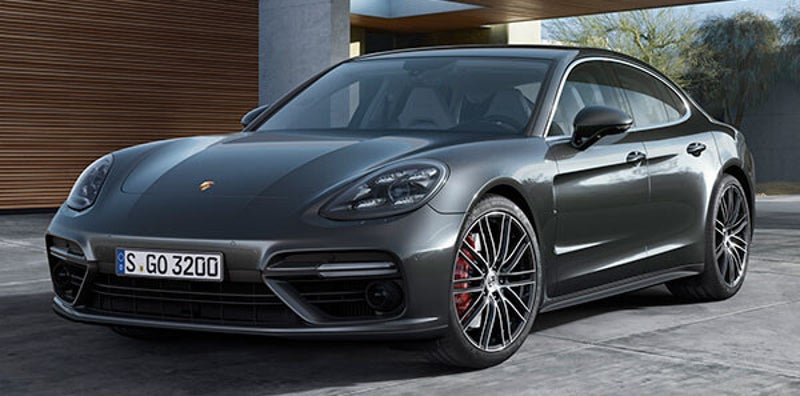
The second generation Panamera was revealed on 28 June 2016 at a special event in Berlin, Germany. Codenamed 971, it is 35 mm (1.4 in) longer, 5 mm wider and 5 mm taller than the first generation Panamera, with a 30 mm longer wheelbase. The interior features a redesigned dashboard layout, with touch-sensitive surfaces replacing the previous generation's array of buttons. A centrally mounted tachometer also harks back to the 1955 Porsche 356 A.
The new car includes two seven-inch displays in place of the dials, as well as a 12.3-inch touchscreen featuring online sat-nav, Apple CarPlay integration and an updated voice control system. Under the bonnet is a new engine range, with only the Panamera 4S, 4S Diesel and flagship Turbo available from launch.
In March 2017, Porsche unveiled the Panamera Turbo S E-Hybrid, a plug-in hybrid for the 2018 model year. The Turbo S E-Hybrid will receive the 4.0 L V8 engine from the Panamera Turbo, but will also be paired with an electric motor. Total system power will be 680 PS, which makes it the third most powerful Porsche ever, after the 918 Spyder and 991 GT2RS.

The Panamera Sport Turismo debuted in March 2017 at the Geneva Motor Show, and is currently available with the same engine range as the 4-door car. In September 2017 Porsche announced the Panamera Turbo S E-Hybrid Sport Turismo, the 5-door estate version of the flagship Turbo S E-Hybrid, which had previously only been available as a 4-door configuration. As of September 2017, the 680 PS (500 kW; 671 bhp) Panamera Turbo S E-Hybrid Sport Turismo is currently the world's most powerful stock estate car, besting the 612 PS Mercedes-AMG E 63 S and the 605 PS Audi RS6 Performance.
panamera III




2023-present
The third generation of the Panamera was officially presented on 24 November 2023, with Porsche providing details for the mid-range Panamera 4 and Turbo E-Hybrid models. For the plug-in Turbo E-Hybrid model, the 370 V traction battery has a storage capacity of 25.9 kW, giving the vehicle a maximum all-electric range of 90 km under the WLTP cycle. The electric motor is integrated into the transmission.
Compared to the second generation, the third generation has a small frontal air inlet above the license plate bracket; other styling changes were characterized as "incremental". The Sport Turismo shooting brake body has been dropped.
Base models are equipped with an air suspension that has two air chambers and twin-valve dampers, independently adjustable for rebound and compression. The E-Hybrid can be equipped with an active suspension as an option, called Porsche Active Ride. The active suspension is designed to stabilize the body under dynamic conditions, such as resisting lean in corners and weight transfer during acceleration and deceleration.
918 spyder




2013-2015
The Porsche 918 Spyder is a limited-production mid-engine plug-in hybrid sports car. The 918 Spyder is powered by a naturally aspirated 4.6 L V8 engine, developing 608 PS at 8,700 rpm, with two electric motors delivering an additional 286 PS for a combined output of 887 PS and 1,280 N⋅m of torque. The 918 Spyder's 6.8 kWh lithium-ion battery pack delivers an all-electric range of 19 km under the US Environmental Protection Agency's five-cycle tests.
Production began on 18 September 2013, with deliveries initially scheduled to begin in December 2013, and a starting price of ~ €711,000. The 918 Spyder was sold out in December 2014 and production ended in June 2015.
The 918 Spyder is powered by a 4,593 cc naturally aspirated V8 engine built on the same architecture as the one used in the RS Spyder Le Mans Prototype racing car without any engine belts. The engine weighs 135 kg according to Porsche and delivers 608 PS. The 4.6 litre V8 petrol engine can recharge an empty battery on about two litres of fuel.
macan
The Porsche Macan is a compact luxury crossover SUV (D-segment) produced by German manufacturer Porsche since 2014. It is the smallest SUV from Porsche below the Cayenne. The first-generation Macan went on production from February 2014 with petrol and diesel engine options. In 2024, Porsche released the second-generation Macan which is a battery electric vehicle built on the dedicated Premium Platform Electric (PPE) EV plattform. The first-generation and second-generation electric Macan will be sold side-by-side, providing multiple powertrain options for consumers.
Since 2015, its first full year in the market, the Macan has been the best-selling Porsche model globally ahead of the larger Cayenne.



first generation 2014-2018
first generation , update 2019-present
The 'Macan' model name was decided in 2012 and is derived from the Indonesian word for tiger. The Porsche Macan shares its platform and wheelbase with the first generation Audi Q5 (2008–2017). The suspension configuration is based on, and heavily modified from the Audi, but the engine, transfer case, suspension tuning, interior and exterior body are unique to the Macan. It is also 43 mm longer and 36 mm wider than a Q5. The Macan is produced alongside the Panamera which it shares a strong resemblance, in Leipzig, Germany in a newly extended factory. The Macan is also intended to be 'sportier' than the Cayenne.
At launch, three different models and engines were available, all being V6 format: a 3.0-litre Macan S with 340 PS, a 3.6-litre Macan Turbo with 400 PS and a 3.0-litre, 258 PS Diesel. The Macan GTS was announced in October 2015 to fit into the gap between the Macan S and Macan Turbo.



second generation 2024-present
On January 25, 2024, Porsche revealed the second-generation Macan which will be available only with a battery electric powertrain. The 2024 Porsche Macan EV is an all-new model, despite sharing its name with the existing gas-powered crossover. Production began in May 2024 at the Leipzig plant alongside the older ICE version of the Macan. Porsche sells the new electric model alongside the original Macan which it updated in 2021. It uses the same Premium Platform Electric (PPE) platform shared with the upcoming Audi Q6 e-tron.
The Macan EV’s dual-motor powertrain produces up to 630 horsepower in the top-level Turbo model, giving the crossover rapid acceleration. It will hit 100 km/h in just 2.9 seconds.
The Macan features three screens: a curved 12.6-inch instrument cluster, a 10.9-inch infotainment system, and an optional 10.9-inch screen for the front passenger. It also utilizes a voice assistant and other driver aid technology.
taycan



2019-present
The Porsche Taycan is an all-electric car made by German automobile manufacturer Porsche. The concept version of the Taycan, named the Porsche Mission E, debuted in 2015. The Taycan was revealed fully production-ready in 2019. As Porsche's first series production electric car, it is sold in several variants at different performance levels, and may spawn further derivatives in future models. More than 20,000 Taycans were delivered in 2020, its debut sale year, representing 7.4% of the total Porsche volume.
The name "Taycan" roughly translates from Turkish as "lively young horse", in reference to the steed of the Stuttgart coat of arms on the Porsche crest.
Porsche named the high performance models Turbo and Turbo S despite the absence of a turbocharger, following the tradition set by high performance Porsche derivatives with internal combustion engines.
The Taycan uses a new battery-electric all-wheel-drive drivetrain with a permanent-magnet synchronous motor on each axle. Power comes from a 93 kWh 630 kg lithium-ion battery pack that doubles as a structural chassis component and keeps the center of gravity low.
taycan cross turismo

taycan sport turismo

The Taycan Cross Turismo is a lifted shooting brake/wagon version of the Taycan with additional body cladding, rugged black plastic trim, and other crossover-like features, including an off-road Design package and 'Gravel' drive mode.
The Sport Turismo shares the estate/shooting brake profile with the Cross Turismo, but deletes the crossover-like styling elements. In addition, all Cross Turismo models are all-wheel-drive, while a RWD model is available for the Sport Turismo (as the base Taycan Sport Turismo)
989 concept car



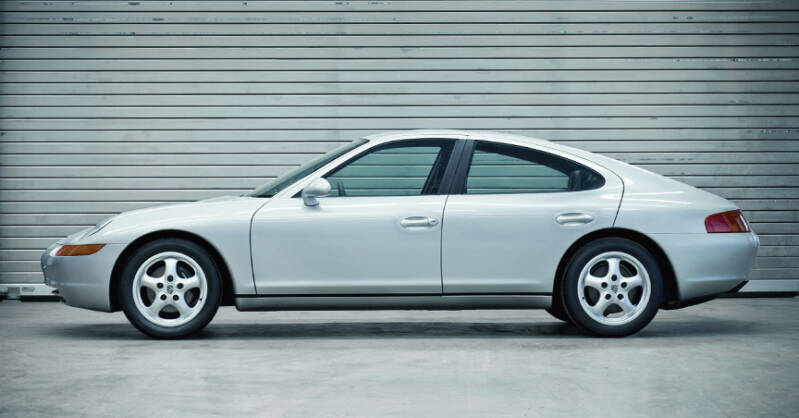
The Porsche 989 was a 4-door performance-oriented touring sedan developed by Porsche between 1988 and 1991. This vehicle was never produced, after development was halted in late 1991 and cancelled in January 1992.
Increased sales of Porsche's 928 model during the mid-1980s prompted executives to consider adding another large, sporty touring vehicle to the lineup, this time a 4-door that could serve as a more practical but equally powerful and exciting alternative to the 928. Porsche engineer Dr. Ulrich Bez was put in charge of the project and given instructions that the vehicle should be luxurious and comfortable but offer a sporting nature superior to that attained by large saloon cars from Mercedes-Benz and BMW. By september 1991, the project lost momentum. The severe slump in 928 sales made executives re-think the viability of the idea, and low overall profits during the 1989 to 1991 model years meant the model would be far more risky for the company to build than had been anticipated during development. In January 1992, development was halted completely.
The Porsche Panamera, launched in 2009, is considered to be the spiritual successor to the 989 project.
tapiro concept car

1970 1 built

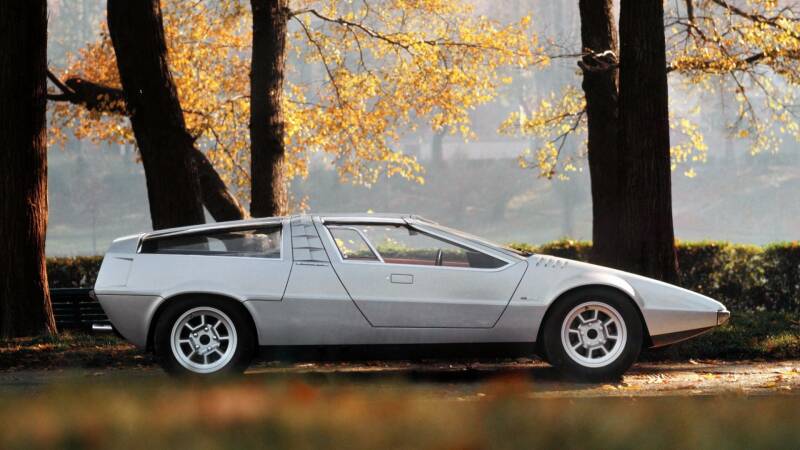

The Porsche Tapiro is a concept car built by Porsche in 1970. It was designed by Giorgetto Giugiaro and has a traditional 1970s wedge design, which critics say somewhat resembles that of the De Tomaso Mangusta. The chassis is based on the Porsche 914/6, and it features gullwing-style doors.
The Tapiro is powered by a longitudinally mounted air-cooled 2.4 liter flat-six engine producing 220 hp at 7,800 rpm, and connected to a 5-speed manual transmission. This engine could propel the Tapiro to an official top speed of 245 km/h.
The Porsche Tapiro was introduced to the world at the 1970 Turin Auto Show, in Turin, Italy. The car subsequently made its US debut at the 5th Annual Los Angeles Imported Automobile and Sports Car Show in 1971.
In 1972, the car was sold to a Spanish industrialist who used it as his daily driver. The car was mostly destroyed after it caught fire. Most sources say the cause of the fire was a group of labor activists protesting its owner's labor policies, who planted a bomb under the Tapiro. The bomb exploded, burning the car but not destroying the chassis. Other sources say the car was involved in an accident and caught fire that way. The burnt shell was repurchased by Italdesign and is now on display in its Giugiaro Museum.
c88


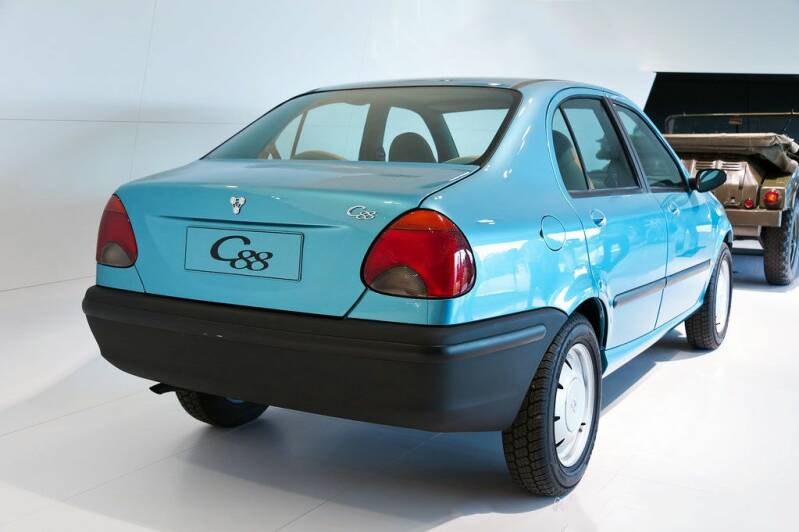

Porsche designed the C88 experimental car for China. The brief was simple: the car had to be cheap, efficient, large enough to carry five people, and be built in China under a joint venture with First Automotive Works (FAW). Given the rate at which the Chinese car market was growing – not to mention the 1.2 billion people who lived there at the time – it’s no surprise that a number of firms responded with plans and prototypes. Porsche was one such company.
In just four months, Porsche created a minor miracle by achieving something that few manufacturers have achieved in a lifetime: it designed and built a desirable compact saloon.
Power was sourced from a 1.1-litre 16-valve engine that could hit 62mph… eventually. For once, Porsche wasn’t interested in performance – what mattered was the efficiency. It kept the weight down to 980kg, which would have meant fuel economy in the region of 49mpg.
There wasn’t a Porsche badge to be found.

Rimac Automobili is a Croatian car manufacturer headquartered in Sveta Nedelja, Croatia, that develops and produces electric sports cars, drivetrains and battery systems. The company was founded in 2009 by Mate Rimac. Rimac Automobili's first model, the Concept One, was the world's fastest production electric vehicle. While manufacturing and marketing high-performance vehicles under its own brand, Rimac also develops and produces battery packs, drivetrain systems, and vehicles for other companies.
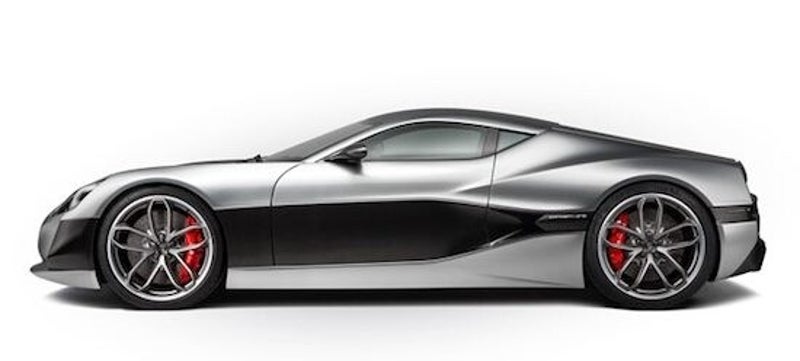
In 2018, Volkswagen group subsidiary Porsche Engineering Group GmbH acquired a 10% stake in Rimac to form a development partnership, as part of its electrification process. Mate Rimac commented: "This partnership now is an important step for Rimac on our way to become a component and system supplier of choice for the industry in electrification, connectivity and the exciting field of Advanced Driver Assistance Systems".
In July 2021, VW Group's Porsche and Rimac announced that they have agreed to create a joint venture that will incorporate Volkswagen's high-performance Bugatti brand. The new venture will be called Bugatti-Rimac. Rimac will have a 55% stake in the joint venture, while Porsche will hold a 45% stake in the company.
racing/ralley

904 Coupé
After having withdrawn from Formula One at the end of the 1962 season, Porsche focused again on sportscar racing. The 904 debuted late in 1963, for the 1964 racing season, as a successor to the 718, which had been introduced in 1957. Porsche designed the GTS variant to compete in the FIA-GT class at various international racing events. The street-legal version debuted in 1964 in order to comply with group 3 appendix J homologation regulations requiring a certain number of road-going variants be sold by the factory.

907
The 907 was introduced at the 1967 24 Hours of Le Mans. Following a suggestion by Ferdinand Piëch, the position of the driver was moved from the traditional left (as in German road cars) to the right as this gives advantages on the predominant clockwise race tracks.
With a new longtail body, the 907s reached 302 km/h on the straight, even though it used the reliable 220 hp Porsche 910 2000cc 6-cyl rather than the more powerful 8-cyl. Vented brake disks were being used as standard from that point on.

le mans gt1
With the revival of international sportscar racing in the mid-1990s through the BPR Global GT Series (which then morphed into the FIA GT Championship) Porsche expressed interest in returning to top-level sportscar racing and went about developing its competitor for the GT1 category. Cars in this category were previously heavily modified versions of road cars, such as the McLaren F1 and the Ferrari F40.
However, when the 911 GT1 was unveiled in 1996, Porsche exploited the rule book to the full and stunned the sportscar fraternity.

919 hybrid
The Porsche 919 Hybrid is a Le Mans Prototype 1 (LMP1) racing car built and used by Porsche in the 2014, 2015, 2016 and 2017 seasons of the FIA World Endurance Championship. It has a two-litre 90-degree V4 mid-mounted mono-turbocharged petrol engine that produces 500 hp (370 kW) and acts as a chassis load-bearing member - and two separate energy-recovery hybrid systems to recover thermal energy from exhaust gases and convert kinetic energy into electrical energy

935
The Porsche 935 was a race car developed and manufactured by German automaker Porsche. Introduced in 1976 as the factory racing version of the 911 (930) Turbo and prepared for FIA-Group 5 rules, it was an evolution of the Carrera RSR 2.1 turbo prototype, the second place overall finisher in the 1974 24 Hours of Le Mans.
Beginning with the 1977 season, Porsche offered the 935 to customers entering the World Championship for Makes, in the IMSA GT Championship and in the German Deutsche Rennsport Meisterschaft (DRM).

956
The Porsche 956 was a Group C sports-prototype racing car designed by Norbert Singer and built by Porsche in 1982 for the FIA World Sportscar Championship. It was later upgraded to the 956B in 1984. In 1983, driven by Stefan Bellof, this car established a record that would stand for 35 years, lapping the famed 20.832 km Nürburgring Nordschleife in 6:11.13 during qualifying for the 1000 km Sports Car race. The record was finally surpassed by Timo Bernhard in a derestricted Porsche 919 Evo on 29 June 2018

961
The Porsche 961 was a racing car built by Porsche and based on their 959 sports car. It was intended for Group B sports car racing, complementing the purpose-built 956 and 962C which ran Group C in the World Sports-Prototype Championship. The 961 project was short lived, running only three races and seeing the construction of only one car. Plans to sell the car to customers were scrapped when the Group B class was canceled.

rs spyder
The RS Spyder (Type 9R6) is a racing car designed by Porsche in conjunction with Penske to compete in Le Mans Prototype Class 2 (LMP2) racing. The car takes its name from the legendary Porsche 550 Spyder of the 1950s (combined with Porsche's common "RennSport" (lit.: racing sports) designation). The car marked Porsche's first return to the top level of sports prototype racing since the firm abandoned its Porsche LMP in 1999.
cayenne electric



2025-now
After a fully electric Macan, Porsche is now also launching a fully electric Cayenne. This will be delivered in addition to the Cayenne with a petrol engine, because it will remain available for a very long time.
From 0-100, the Cayenne Turbo Electric is just as fast as a new Porsche 911 Turbo S, namely 2.5 seconds. And up to 200 km/h, at 7.4 seconds, it is even a full second faster than Porsche's famous sprint cannon. Indeed, this behemoth wins a drag race against the 911 Turbo S thanks to 1156 hp.
For now the Turbo S and the base Cayenne, with 408 hp, is the only variant you can buy after the reveal. Of course, there will be S and GTS versions later.
The car always gets a 113-kWh battery pack, there is no smaller battery planned. This will get you 620 to 640 paper kilometers.
Porsche has therefore developed the electric motor on the rear axle in-house. It is a permanent magnet synchronous motor (PMS) that has permanent oil cooling. This guarantees top performance, even when riding on track or desert wrestling. The range of the e-motor is such that a two-speed automatic transmission, like the Taycan had, was not necessary here. Both the desired top speed (more than 260 km/h) and the sprint could be achieved with one gear.
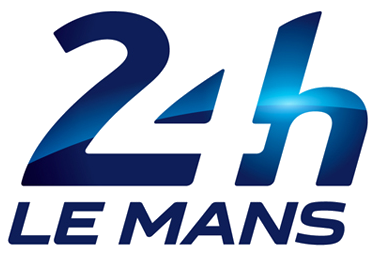
917
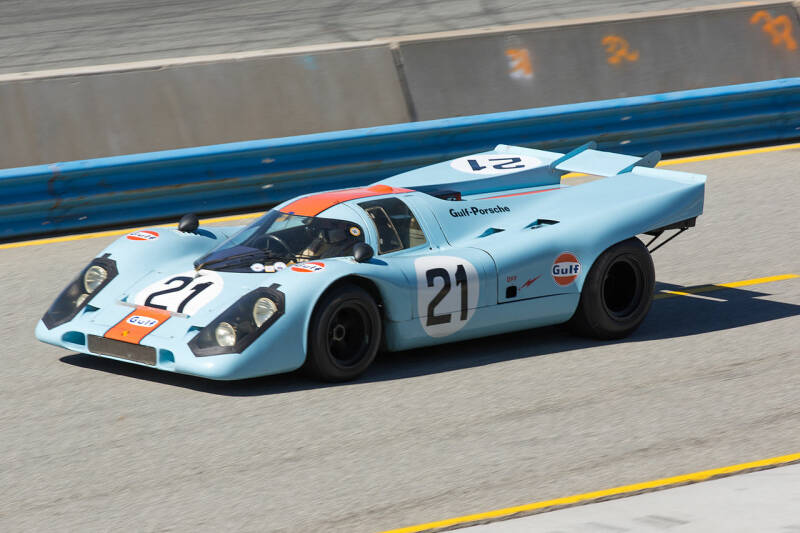
1969-1973



The Porsche 917 is a sports prototype race car developed by German manufacturer Porsche. The 917 gave Porsche its first overall wins at the 24 Hours of Le Mans in 1970 and 1971. Powered by the Type 912 flat-12 engine of 4.5, 4.9, or 5 liters, the 917/30 Can-Am variant was capable of 0-100 km/h time of 2.3 seconds and 0–200 km/h in 5.3 seconds. The long tail Langheck version had a maximum measured top speed of 362 km/h.
In 1971 the car featured in the Steve McQueen film Le Mans. In 2017 the car driven by McQueen in the film was sold at auction for $14m, a record price for a Porsche. For the 40th anniversary of the 917 in 2009 Porsche held a special celebration at the Goodwood Festival of Speed.
Power came from a new 4.5-litre air-cooled engine designed by Mezger, which was a combination of 2 of Porsche's 2.25L flat-6 engines used in previous racing cars. To keep the car compact despite the large engine, the driving position was so far forward that the feet of the driver were beyond the front wheel axle.
There were a number of versions of Porsche 917 made over the years; at least eleven different versions have existed.
956

1982



To correspond with Group C racing first introduced by the FIA, Porsche designed the 956. Their program, led experienced project manager Norbert Singer, placed strong emphasis on winning the 1982 Le Mans. That year, Porsche made a clean sweep; first second and third was theirs. The lack of any real competition in 1982 practically handed them the championship, but due to their tremendous team, and the newly developed Weissach facility, Porsche turned the 956 into a customer prototype that would rule motorsport for a decade.
The 956 was meant to replace the all dominant Porsche 935 and 936. When designing the prototype, Porsche decided to use the flat-6 which had proven itself, powering the 936 to victory at Le Mans. Around this engine Porsche focused on building a car that was above all, aerodynamically efficient, and to do that ground effects were employed. To balance the downforce created ground effects, a venturi in between the front wheels complemented the large downforce created by the rear wing and much larger rear venturi.
Porsche 956s dominated the 1982 and 1983 seasons, and afterwards evolved into into a well-developed customer car. As Porsche was the only company selling prototype race cars, they were the car to buy and teams such as Joest, Kremer, John Fitzpatrick, Richard Lloyd, Brum Motorsports and Nova Engineering did just that.
919

2014-2017



The Porsche 919 Hybrid is a Le Mans Prototype 1 (LMP1) racing car built and used by Porsche in the 2014, 2015, 2016 and 2017 seasons of the FIA World Endurance Championship. It has a two-litre 90-degree V4 mid-mounted mono-turbocharged petrol engine that produces 500 hp and acts as a chassis load-bearing member - and two separate energy-recovery hybrid systems to recover thermal energy from exhaust gases and convert kinetic energy into electrical energy under braking for storage into lithium-ion battery packs. In accordance with the 2014 regulations, the vehicle was placed in the 6 MJ (1.7 kWh) class.
In 2015, the car was further developed and was categorized into the 8 MJ (2.2 kWh) category. Bernhard, Hartley, and Webber won four out of eight races to claim the 2015 World Endurance Drivers' Championship and the World Manufacturers' Championship. Earl Bamber, Nico Hülkenberg and Nick Tandy won the 6 Hours of Spa-Francorchamps and 24 Hours of Le Mans, driving a third 919 Hybrid. In 2016 Dumas, Jani, and Lieb won the 6 Hours of Silverstone and the 24 Hours of Le Mans with the car after further development. The next year, 2017, Tandy and former Audi LMP1 driver André Lotterer joined Jani in place of Dumas and Lieb, and Bamber teamed up with Bernhard and Hartley, replacing the retired Webber. Porsche finished on the podium in the first two rounds.
After 2017, the 919 Hybrid project was discontinued to allow Porsche to enter Formula E and an evolution of the car called the 919 Evo, which was demonstrated in 2018.
963




2023-present
Revealed at the Goodwood Festival of Speed 2022, the 963 will compete in the 2023 World Endurance Championship and the US-based IMSA WeatherTech SportsCar Championship, kicking off with the 24 hours of Daytona in January and then Le Mans, Sebring and Road Atlanta. Tthe Porsche 963 is based on an LMP2-category (the class below LMDh) chassis supplied by Multimatic, a firm that helped develop the Ford GT road car and suspension for Ferrari’s 296 GTB Assetto Fiorano pack model.
Underneath the bodywork lies a twin-turbo 4.6-litre V8 engine producing 671bhp. This new motor is based on the same engine as fitted to the firm’s 918 Spyder road car, released in 2013. Together with the electrical assistance, the powertrain is good for 670 hp.






In the late 1950s the Porsche 718 RSK, a two-seater sports car, was entered in Formula Two races, as rules permitted this, and lap times were promising. The 718 was first modified by moving the seat into the center of the car, and subsequently proper open wheelers were built. These 1500 cc cars enjoyed some success. The former F2 cars were moved up to Formula One in 1961, where Porsche's outdated design was not competitive. For 1962, a newly developed flat-eight powered and sleek Porsche 804 produced Porsche's only win as a constructor in a championship race, claimed by Dan Gurney at the 1962 French Grand Prix. One week later, he repeated the success in front of Porsche's home crowd on Stuttgart's Solitude in a non-championship race. At the end of the season, Porsche withdrew from F1 due to the high costs, just having acquired the Reutter factory. Volkswagen and German branches of suppliers had no interest in an F1 commitment as this series was too far away from road cars. Privateers continued to enter the out-dated Porsche 718 in F1 until 1964.

1962 804
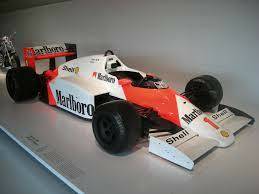


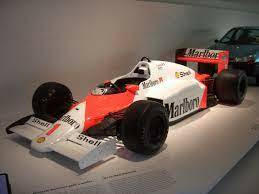
Having been very successful with turbocharged cars in the 1970s, Porsche returned to Formula One in 1983 after nearly two decades away, supplying water-cooled V6 turbo engines badged as TAG units for the McLaren Team. For aerodynamic reasons, the Porsche-typical flat engine was out of the question for being too wide. With turbo power being the way to go in F1 at the time a 90° V6 turbo engine was produced. The TAG engine was designed to very tight requirements issued by McLaren's chief designer John Barnard. He specified the physical layout of the engine to match the design of his proposed car. The engine was funded by TAG who retained the naming rights to it, although the engines bore "made by Porsche" identification. Initially, Porsche were reluctant to have their name on the engines, fearing bad publicity if they failed. However, within a few races of the 1984 season when it became evident that the engines were the ones to have, the "Made by Porsche" badges began to appear. TAG-Porsche-powered cars took two constructor championships in 1984 and 1985, and three driver crowns in 1984, 1985 and 1986. The engines powered McLaren to 25 victories between 1984 and 1987, with 19 for 1985 and 1986 World Champion Alain Prost, and 6 for 1984 Champion Niki Lauda.
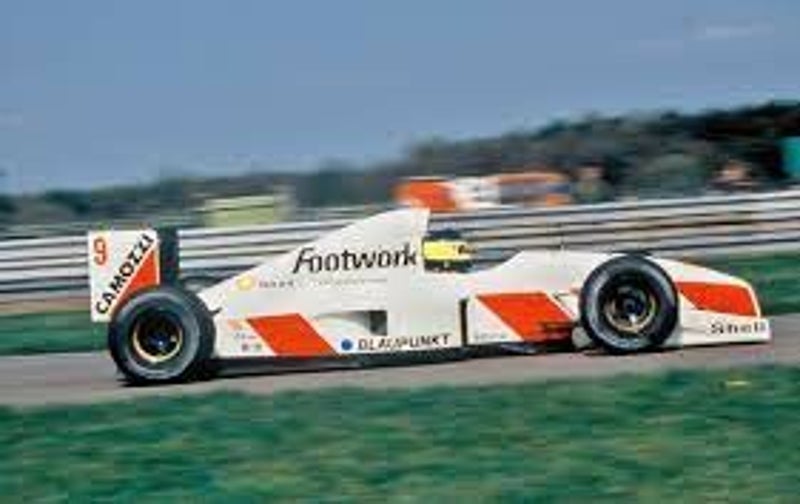



Porsche returned to F1 again in 1991 as an engine supplier, however, this time with disastrous results: The Footwork Arrows cars powered with the overweight Porsche 3512 double-V6 which weighed 400 pounds (180 kg), (according to various reports, including from McLaren designer Alan Jenkins, the engine was in fact 2 combined TAG V6 engines used by McLaren from 1983 to 1987 minus the turbochargers) failed to score a single point, and failed even to qualify for over half the races that year. After the Porsche engines were sacked by Footwork in favor of Cosworth DFRs, Porsche has not participated in Formula One since. According to reports from Arrows, the 3512's major problem, other than a lack of horsepower, was severe oil starvation problems which often led to engine failure.















Create Your Own Website With JouwWeb